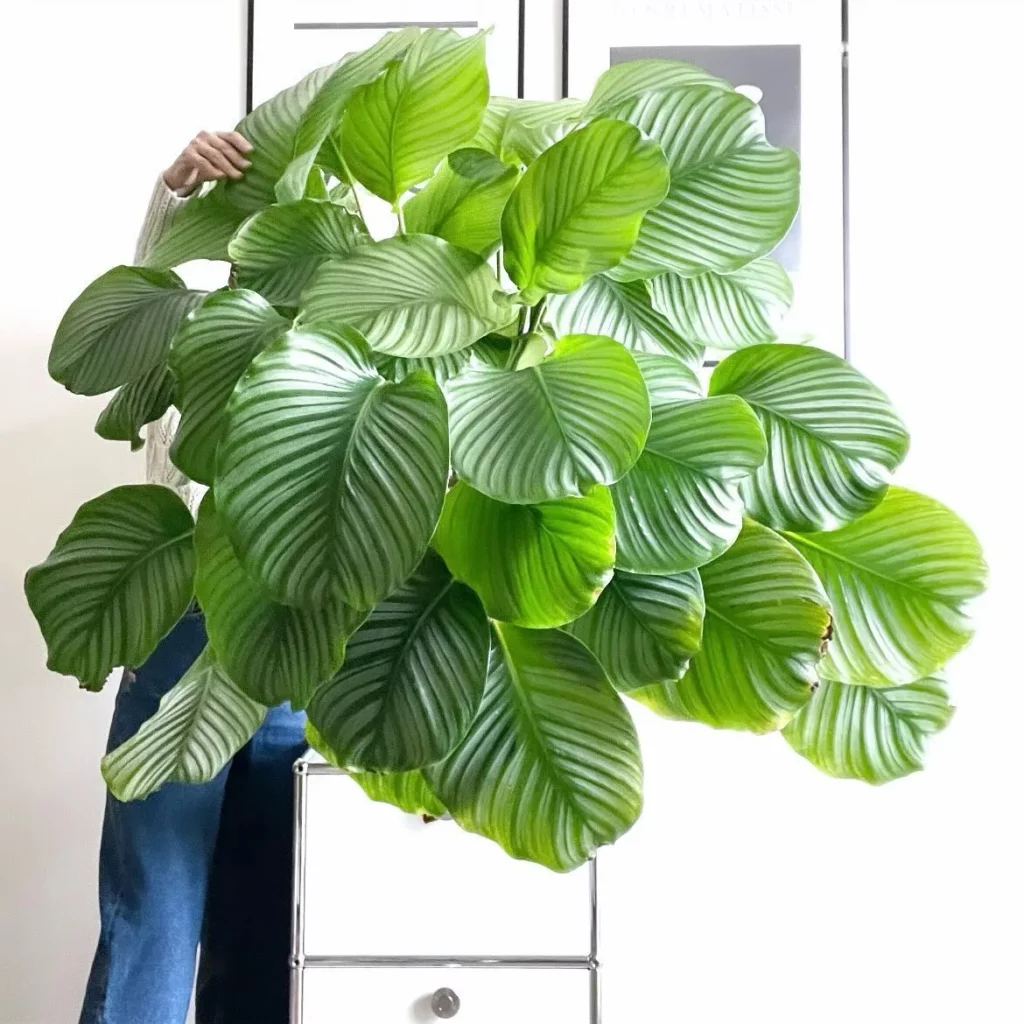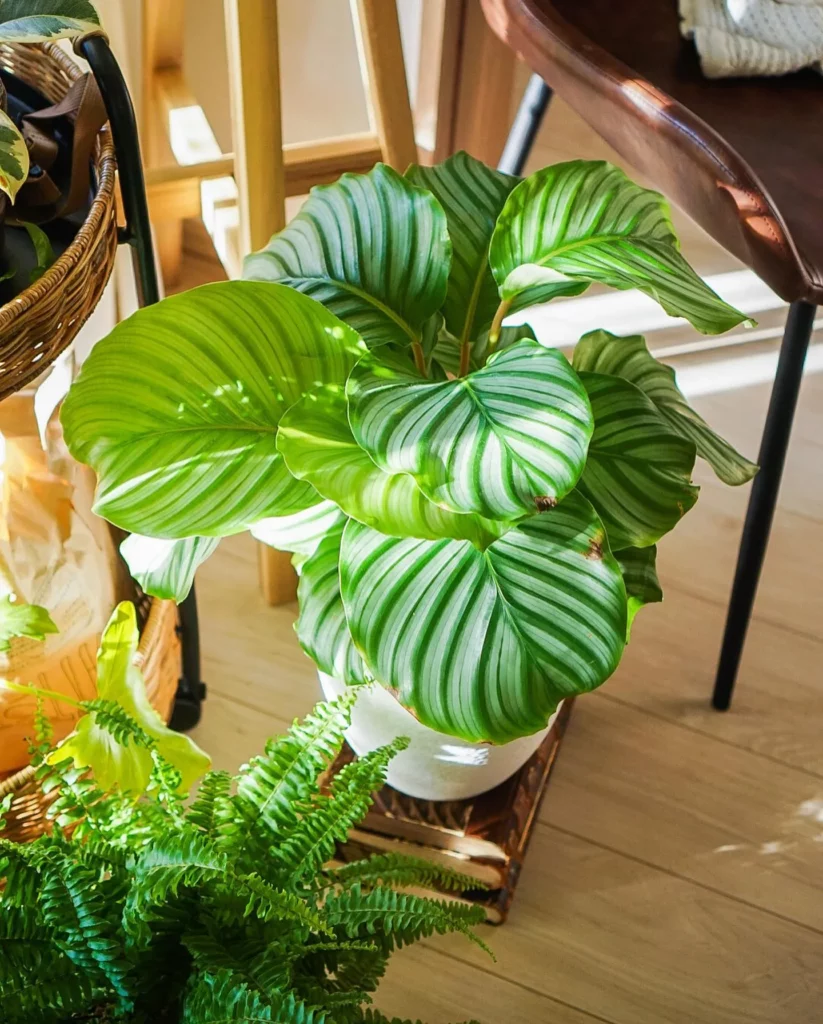Trim away yellow or brown leaves at the base to keep your Calathea healthy and vibrant.
This guide demystifies Calathea pruning, offering step-by-step instructions and insights for beginners and seasoned gardeners alike to maintain their plant’s health and aesthetics. Learn the best techniques to encourage healthy growth, shape maintenance, and pest prevention, ensuring your Calathea remains a thriving indoor beauty.
No products found.
Understanding Calathea Growth Habits

Before you start pruning your Calathea plants, it’s important to understand their growth habits. Knowing how Calatheas grow and develop will help you make informed decisions when it comes to pruning and trimming.
In this section, I will explain the typical growth patterns of Calatheas, focusing on their leaf growth and development.
Calatheas are known for their vibrant and ornamental foliage, which adds a touch of elegance to any indoor space. These tropical plants have a natural rhythm of growth, with new leaves emerging from the center of the plant and older leaves gradually maturing and eventually fading.
Calathea leaves typically unfurl from a rolled-up position, revealing their intricate patterns and colors. As the leaves mature, they reach their full size and display their characteristic markings, which can vary depending on the specific Calathea variety. Some Calatheas have bold stripes or spots, while others exhibit delicate patterns that resemble brush strokes.
It’s essential to note that Calathea leaves move throughout the day, a phenomenon known as “nyctinasty.”
This movement, where the leaves raise and lower in response to light changes, is a natural adaptation to the plant’s environment. Understanding this behavior is important when positioning your Calathea in your home and when deciding which leaves to prune.
No products found.
Leaf Growth and Development
The growth and development of Calathea leaves can be divided into distinct stages. During the initial stage, the leaves emerge as young, tightly rolled-up structures from the center of the plant. As the leaves unfurl, they gradually unfurl their patterns and colors, revealing their unique beauty.
Once the leaves reach their full size and have fully unfurled, they enter the mature stage. Calathea leaves are at their peak during this stage, displaying their vibrant colors and intricate markings. It is during this period that the leaves contribute to the overall aesthetics of the plant.
Over time, as new leaves emerge, the older leaves will enter the aging stage. During this stage, the leaves may start to lose some of their vibrancy and develop signs of wear and tear.
It’s important to closely monitor your Calathea plants during this stage to identify any signs of stress or disease that may require pruning.
Understanding the different stages of leaf growth and development in Calatheas will help you assess the health of your plants and make informed decisions when it comes to pruning.
Proper pruning will not only enhance the overall appearance of your Calathea but also promote healthy new growth.
When to Prune Calathea Plants

Pruning Calathea plants at the right time is essential for their overall health and vigor.
In this section, I will guide you on identifying the best time to prune your Calatheas to achieve optimal results. By understanding the growth cycle of these plants and recognizing specific signs, you can ensure successful pruning.
1. Growth Cycle:
- Calathea plants typically go through a period of active growth during the spring and summer months. This is the ideal time to prune as the plants have abundant energy to recover quickly.
- During the fall and winter, Calatheas enter a dormancy phase where growth slows down. Pruning during this period may hinder their recovery.
2. Signs to Look for:
- Look for faded or discolored leaves that have lost their vibrancy. These are good candidates for pruning as they may indicate declining health.
- Inspect the plant for any signs of pests or diseases. Pruning affected leaves can help prevent the spread of infestations.
- Remove any dead or yellowing leaves that are no longer contributing to the plant’s aesthetics or overall health.
Tools and Equipment for Pruning

When it comes to pruning your Calathea plants, having the right tools and equipment is essential. In this section, I will introduce you to the necessary pruning tools and provide tips on choosing the best ones for your needs.
Additionally, I will share insights on proper tool maintenance to ensure their longevity and effectiveness.
Essential Pruning Tools
1. Pruning Shears: These are the most commonly used tools for pruning. Look for shears with a sharp blade and a comfortable grip that allows you to make precise cuts without straining your hand or wrist.
2. Pruning Scissors: Pruning scissors, also known as hand pruners or secateurs, are suitable for trimming smaller branches and stems. Opt for a pair with a sturdy build and a bypass cutting mechanism for cleaner cuts.
3. Pruning Saw: For larger branches or thick stems, a pruning saw is necessary. Choose a saw with a curved blade and special teeth designed for cutting through wood without excessive effort.
Choosing the Right Tools
When selecting pruning tools, consider the size and type of your Calathea plants.
Smaller plants may require only pruning scissors, while larger, more established plants may necessitate the use of shears and a pruning saw. Ensure that the tools you choose are sharp, well-maintained, and suited to the specific tasks at hand.
Tool Maintenance Tips
- Regularly clean your tools after each use to prevent the spread of disease or pests. Use a solution of water and mild soap, wiping down the blades and handles.
- Sharpen the cutting edges of your pruning shears and scissors regularly using a sharpening stone or a specialized pruning tool sharpener.
- Oil the moving parts of your tools, such as the pivot points, to keep them lubricated and functioning smoothly.
- Store your pruning tools in a dry, clean place to prevent rusting and damage.
Step-by-Step Guide to Pruning Calathea

Now that you have the necessary tools, I will guide you through the step-by-step process of pruning your Calathea plants. Proper pruning is essential for maintaining the health and appearance of your Calatheas, so let’s dive in!
- Assess the leaves: Start by examining your Calathea plant and identifying any dead, damaged, or discolored leaves. These are the leaves that you will need to prune.
- Gather your tools: Make sure you have a sharp pair of pruning shears or scissors. This will ensure clean cuts and minimize the risk of damaging the plant.
- Clean your tools: Before you begin pruning, it’s important to sterilize your tools to prevent the spread of diseases. You can use rubbing alcohol or a solution of 1 part bleach to 9 parts water to disinfect your pruning equipment.
- Make the cut: Carefully trim the identified leaves by cutting them at the base where they meet the stem. Aim for a clean and precise cut to promote quicker healing.
- Dispose of pruned leaves: After pruning, remove the pruned leaves from the plant and dispose of them properly. This will help prevent the spread of pests and diseases.
- Monitor for regrowth: Keep an eye on your Calathea plant after pruning. New leaves should start to grow in place of the pruned ones, indicating healthy regrowth.
Trimming Calathea Foliage

Trimming the foliage of your Calathea plants is an essential part of their overall care. It helps maintain the plant’s shape, promotes healthy new growth, and ensures their overall health and vitality.
When it comes to trimming Calathea foliage, there are a few important considerations to keep in mind.
First, it’s crucial to remove any brown or yellowing leaves. These leaves are often a sign of stress, disease, or improper care, and removing them can help redirect the plant’s energy towards healthy growth.
When trimming the leaves, it’s important to use clean and sharp pruning shears or scissors. This will ensure clean cuts that minimize damage to the plant.
Additionally, make sure to sanitize your tools before and after each use to prevent the spread of diseases or pests.
When deciding which leaves to trim, focus on removing those that are damaged, dead, or interfering with the overall shape of the plant. Aim to create a balanced and aesthetically pleasing appearance by maintaining the plant’s natural form.
As you trim the foliage, take care not to remove too many leaves at once. Gradual pruning allows the plant to adjust and recover without excessive stress. Remember, moderation is key when it comes to trimming Calathea foliage.
An important tip to keep in mind is to avoid cutting the central stem or petiole of the leaves. These structures contain important vascular tissues that transport water and nutrients throughout the plant. Removing them can cause significant damage and may hinder the plant’s overall health.
Pruning for Pest and Disease Management

Pruning is an essential practice for maintaining the health and vitality of your Calathea plants. Not only does it help in controlling the growth and shape of your plants, but it can also play a crucial role in managing pests and diseases that can affect your beloved Calatheas.
Common Pests
Calathea plants are susceptible to various pests, including spider mites, aphids, and mealybugs. These pests can weaken your plants, cause yellowing or curling of leaves, and even lead to overall decline if left unchecked.
Pruning infected parts can help remove the source of infestation and limit their spread to other areas of the plant.
Plant Diseases
Calatheas are also susceptible to certain diseases, such as leaf spot and root rot. These diseases can negatively affect the health and appearance of your plants, leading to wilting leaves, discoloration, or stunted growth.
By pruning affected leaves or stems, you can prevent the further spread of the disease and promote the growth of healthy foliage.
Tips for Pruning
When pruning your Calathea plants for pest and disease management, it is important to follow proper sanitation practices to minimize the risk of spreading the pests or diseases.
- Use clean and sharp pruning tools to make precise cuts and minimize damage to the plant.
- Wipe the blades of pruning tools with rubbing alcohol or a disinfectant solution between each cut to prevent cross-contamination.
- Make sure to dispose of the pruned plant material carefully, either by sealing it in a plastic bag or burning it, to prevent reinfestation or disease spread.
Tips for Pruning Calathea Varieties

Calatheas are known for their stunning foliage and come in a variety of different species, each with its own unique growth habits and leaf patterns. To ensure the health and beauty of your Calathea plants, it’s essential to approach pruning with consideration for their specific needs.
1. Calathea Orbifolia:
Calathea Orbifolia is cherished for its large and round leaves with beautiful silver markings. When pruning this variety, focus on removing any yellowing or damaged leaves to maintain the plant’s overall appearance.
Use sharp pruning shears to make clean cuts near the base of the stem or at the point where the leaf attaches to the main stem.
2. Calathea Medallion:
Calathea Medallion showcases dark green leaves with striking round patterns in shades of silver and pink. When pruning this variety, aim to remove any browning or dead foliage to enhance its visual appeal.
Gently trim the damaged leaves at an angle, making sure to avoid cutting into the healthy tissue.
3. Calathea Beauty Star:
Calathea Beauty Star features elongated leaves with intricate patterns of white and green. To prune this variety, observe for any discolored or dying leaves and remove them promptly.
Trim back the damaged leaves close to the stem, ensuring a smooth cut that promotes healthy growth.
Common Mistakes to Avoid When Pruning Calathea

When it comes to pruning your Calathea plants, it’s important to avoid common mistakes that can hinder their growth and health. Even experienced gardeners can make these pruning errors unintentionally.
To help you maintain the beauty and vitality of your Calatheas, I’ll share some of the most common mistakes to avoid:
- Over-Pruning: Some gardeners tend to go overboard with pruning, removing too many leaves at once. This can weaken the plant and disrupt its natural balance. It’s important to only remove the necessary foliage and not exceed the recommended pruning guidelines.
- Using Dull Tools: Pruning with blunt or dull tools can result in jagged cuts, which can make it difficult for the plant to heal properly. Always ensure your pruning shears are sharp and clean to make clean, precise cuts.
- Removing Healthy Foliage: It’s crucial to only prune damaged, diseased, or dead foliage. Removing healthy leaves unnecessarily can stunt the growth of your Calathea plants and disrupt their overall well-being. Take care to only prune what is necessary.
- Improper Timing: Pruning at the wrong time can negatively impact your Calatheas. Avoid pruning when the plants are under stress or in periods of active growth. It’s best to prune during their dormant or resting phase to minimize stress and maximize recovery.
- Not Sanitizing Tools: Failing to sanitize your pruning tools before and after each use can introduce pathogens to the plant, leading to infections or diseases. Remember to clean your tools with disinfectant to prevent the spread of harmful microorganisms.
Aftercare and Maintenance

Now that you’ve successfully pruned your Calathea plants, it’s important to provide them with proper aftercare and maintenance to ensure their continued well-being.
By following these essential tips, you’ll be able to keep your pruned Calatheas thriving and looking their best for years to come.
1. Watering
Calatheas prefer consistently moist but not waterlogged soil. Water your plants when the top inch of soil feels dry to the touch.
Use filtered or distilled water to prevent the build-up of minerals that can damage the foliage. Ensure proper drainage by using well-draining soil and pots with drainage holes.
2. Fertilizing
Feed your Calatheas with a balanced fertilizer specifically designed for houseplants. Follow the recommended dosage instructions, usually applied every 2-4 weeks during the growing season.
Avoid over-fertilizing, as it can lead to nutrient burn and damage the roots.
3. Light and Temperature
Calatheas thrive in bright, indirect light. Place them near a north or east-facing window, away from direct sunlight. These plants also prefer temperatures between 60-80°F (15-27°C), avoiding extreme temperature fluctuations and cold drafts.
4. Humidity
Calatheas love humidity! Increase humidity levels by placing a tray of water near your plants or using a humidifier. You can also mist your plants regularly or create a humid microclimate by grouping them together.
5. Cleaning
Keep your Calathea’s foliage clean by gently wiping the leaves with a damp cloth or using a soft brush to remove dust. This will allow your plants to breathe and photosynthesize more efficiently.
6. Pruning Maintenance
Regularly inspect your pruned Calatheas for any signs of new growth, damaged leaves, or pests. Remove any brown or yellowing leaves promptly to maintain the plant’s overall health and appearance.
Enjoying the Benefits of Pruned Calathea Plants

Pruning your Calathea plants is not only essential for their overall health but also an underrated way to enhance their aesthetic appeal.
By regularly pruning your Calatheas, you can enjoy a multitude of benefits that contribute to the well-being of both your plants and your indoor environment.
One of the significant advantages of pruning Calatheas is the improved air circulation it promotes. By removing dead or overcrowded foliage, you allow fresh air to circulate freely around the plant, reducing the risk of stagnant air pockets that can lead to pests or diseases.
This increased airflow also helps the plants in efficient respiration, ultimately leading to healthier growth and vitality.
Another benefit of pruning is the prevention of overcrowding. As Calatheas grow, they naturally produce new leaves from the center, which can sometimes result in a dense and congested foliage arrangement.
Regular pruning helps maintain an open and well-spaced growth habit, allowing each leaf to receive adequate light and space to thrive. This process prevents the plants from becoming overcrowded, ensures optimal light penetration, and helps maintain the overall aesthetics of the plant.
Lastly, pruning your Calathea plants can bring you the joy of having flourishing indoor plants. By removing damaged, yellowed, or unsightly foliage, you create a visually pleasing and vibrant plant display.
The act of pruning itself can be therapeutic and rewarding, as you witness the rejuvenated beauty and health of your plants. A well-pruned Calathea not only adds a touch of greenery to your indoor space but also creates a calming and inviting atmosphere.





